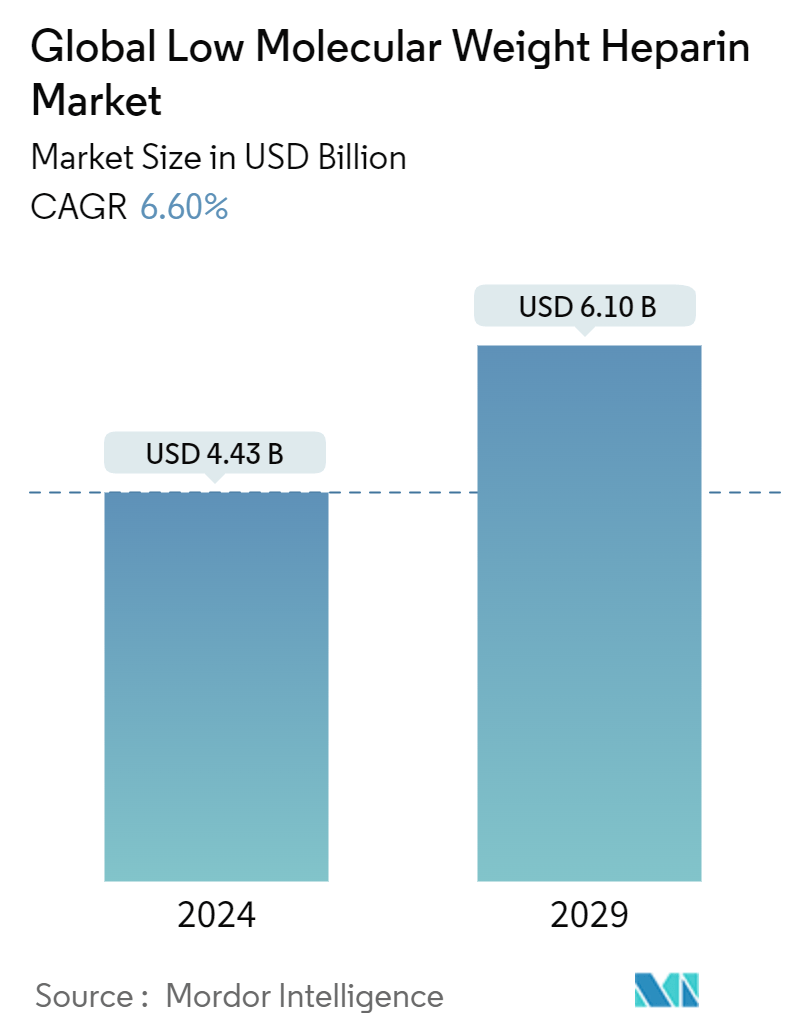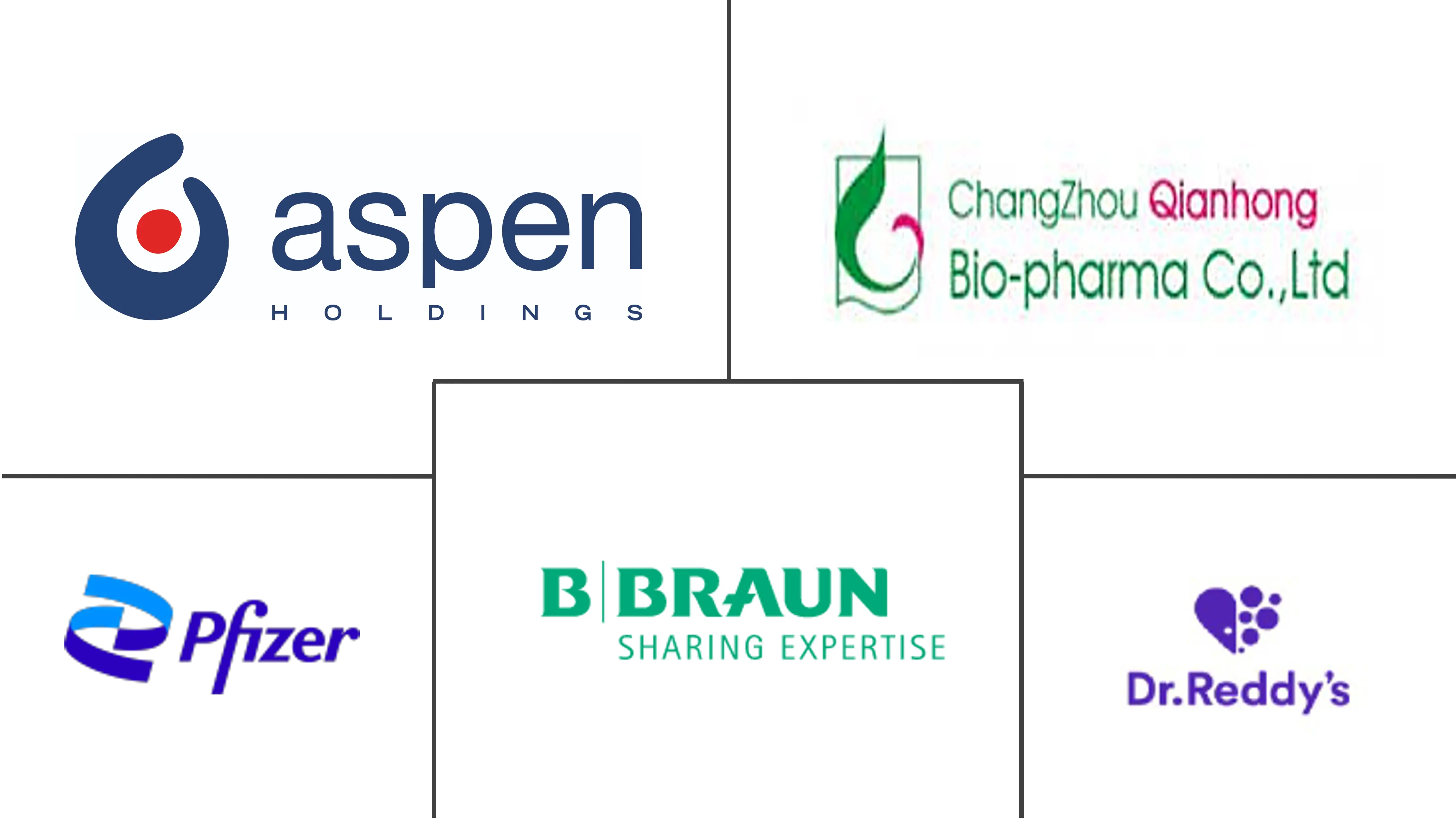Market Size of Global Low Molecular Weight Heparin Industry

| Study Period | 2019 - 2029 |
| Market Size (2024) | USD 4.43 Billion |
| Market Size (2029) | USD 6.10 Billion |
| CAGR (2024 - 2029) | 6.60 % |
| Fastest Growing Market | Asia-Pacific |
| Largest Market | North America |
Major Players
*Disclaimer: Major Players sorted in no particular order |
Global Low Molecular Weight Heparin Market Analysis
The Global Low Molecular Weight Heparin Market size is estimated at USD 4.43 billion in 2024, and is expected to reach USD 6.10 billion by 2029, growing at a CAGR of 6.60% during the forecast period (2024-2029).
The increasing prevalence of blood disorders and the introduction of low-molecular-weight heparin (LMWH) anticoagulants are among the significant factors driving the growth of the market. For instance, the study published in the Journal of Cureus in October 2023 reported the prevalence of deep vein thrombosis was 7% among adult surgical patients in Aseer Central Hospital in Saudi Arabia. Deep vein thrombosis is the most common preventable cause of death in hospitals, accounting for 10% of all deaths from pulmonary embolism (PE), which occurs when a blood clot from a vein in the leg travels to the lungs. Similarly, according to the Leukemia and Lymphoma Society (LLS), around every 3 minutes, one individual in the United States is diagnosed with leukemia, lymphoma, or myeloma. Moreover, as per the same source, 184,720 people in the United States were estimated to be diagnosed with leukemia and lymphoma in 2023. In addition, 89,380 people were expected to be diagnosed with lymphoma in the United States in 2023, with 8,830 new cases of Hodgkin's lymphoma and 80,550 new cases of non-Hodgkin's lymphoma. Low-molecular-weight heparin is used for the prevention of blood clotting and is indicated for venous thromboembolism, other thrombolytic disorders, and blood cancers. Thus, the rising cases of such disorders are likely to fuel the demand for low-molecular-weight heparin products.
According to the National Institutes of Health (NIH) data published in February 2022, LMWH such as dalteparin and enoxaparin is used to prevent venous thromboembolic disease (VTE) during an acute or elective hospital stay, as well as to treat deep vein thrombosis (DVT) and pulmonary embolism (PE). As per the same source, over half of the patients admitted to hospitals who are severely ill are at risk of thromboembolic illness, and VTE is responsible for 5% to 10% of hospital mortality, necessitating accurate VTE risk assessment and effective treatment. Such instances will likely positively impact the market's growth over the forecast period.
Therefore, owing to factors such as the increasing prevalence of blood disorders and the significant effectiveness of LMWH, the market is anticipated to witness growth over the forecast period. However, the adverse effects of low molecular weight heparin are likely to impede market growth.
Global Low Molecular Weight Heparin Industry Segmentation
As per the scope of the report, low molecular weight heparin (LMWH) is a class of anticoagulants. These anticoagulants are used to prevent blood clots and treat venous thromboembolism (deep vein thrombosis and pulmonary embolism) and myocardial infarction. According to the Nonclinical Development of Novel Biologics, Biosimilars, Vaccines, and Specialty Biologics, LMWHs are heparin salts with an average molecular weight of less than 8,000 Da; they have at least 60% of all chains have a molecular weight of less than 8,000 Da.
The LMWH Market is segmented by product type, application, end user, and geography. By product type, the market is segmented into enoxaparin, dalteparin, tinzaparin, fondaparinux, and others. By application, the market is segmented into deep vein thrombosis, acute coronary syndrome (ACS), pulmonary embolism, and other applications. By end user, the market is segmented into hospitals and clinics, ambulatory surgical centers, and other end users. By geography, the market is segmented into North America, Europe, Asia-Pacific, the Middle East and Africa, and South America. The report also covers the estimated market sizes and trends for 17 countries across major regions globally. For each segment, the market size is provided in terms of value (USD).
| By Product Type | |
| Enoxaparin | |
| Dalteparin | |
| Tinzaparin | |
| Fondaparinux | |
| Others |
| By Application | |
| Deep Vein Thrombosis | |
| Acute coronary syndrome (ACS) | |
| Pulmonary Embolism | |
| Others (Aerial Thrombosis, Bypass Surgery, Kidney Dialysis, and Blood Transfusions ) |
| By End User | |
| Hospitals | |
| Clinics | |
| Ambulatory Surgical Centers | |
| Others (Pharmaceutical and Biotechnology Companies and Research Laboratories and Institutes) |
| Geography | ||||||||
| ||||||||
| ||||||||
| ||||||||
| ||||||||
|
Global Low Molecular Weight Heparin Market Size Summary
The low molecular weight heparin (LMWH) market is poised for significant growth, driven by the increasing prevalence of blood disorders and the effectiveness of LMWH anticoagulants in preventing and treating conditions such as deep vein thrombosis (DVT) and pulmonary embolism (PE). The market is expected to expand as LMWH products are increasingly used to address venous thromboembolism and other thrombolytic disorders, particularly in hospital settings where patients are at higher risk. The rising incidence of blood cancers, such as leukemia and lymphoma, further fuels the demand for these anticoagulants. Despite the potential adverse effects associated with LMWH, its benefits in preventing thromboembolic events are anticipated to support market growth over the forecast period.
Regionally, North America is expected to lead the market due to the growing burden of age-related diseases and the increasing number of product approvals. The aging population in the United States, coupled with the high prevalence of DVT and related conditions, underscores the need for effective anticoagulant therapies. The competitive landscape of the LMWH market is moderately fragmented, with several global and regional players such as Changzhou Qianhong Bio-Pharma, Aspen Holdings, and Pfizer Inc. actively participating. Recent product approvals and launches, such as Momenta Pharmaceuticals' M-Enoxaparin and Techdow USA's generic Enoxaparin Sodium, highlight the dynamic nature of the market and the ongoing efforts to meet the rising demand for LMWH products.
Global Low Molecular Weight Heparin Market Size - Table of Contents
-
1. MARKET DYNAMICS
-
1.1 Market Overview
-
1.2 Market Drivers
-
1.2.1 Increased Prevalence of Blood Disorders Worldwide
-
1.2.2 Introduction of LMWH Anticoagulants
-
-
1.3 Market Restraints
-
1.3.1 Adverse Effects of Low Molecular Weight Heparin
-
-
1.4 Porter's Five Forces Analysis
-
1.4.1 Threat of New Entrants
-
1.4.2 Bargaining Power of Buyers/Consumers
-
1.4.3 Bargaining Power of Suppliers
-
1.4.4 Threat of Substitute Products
-
1.4.5 Intensity of Competitive Rivalry
-
-
-
2. MARKET SEGMENTATION (Market Size by Value - USD)
-
2.1 By Product Type
-
2.1.1 Enoxaparin
-
2.1.2 Dalteparin
-
2.1.3 Tinzaparin
-
2.1.4 Fondaparinux
-
2.1.5 Others
-
-
2.2 By Application
-
2.2.1 Deep Vein Thrombosis
-
2.2.2 Acute coronary syndrome (ACS)
-
2.2.3 Pulmonary Embolism
-
2.2.4 Others (Aerial Thrombosis, Bypass Surgery, Kidney Dialysis, and Blood Transfusions )
-
-
2.3 By End User
-
2.3.1 Hospitals
-
2.3.2 Clinics
-
2.3.3 Ambulatory Surgical Centers
-
2.3.4 Others (Pharmaceutical and Biotechnology Companies and Research Laboratories and Institutes)
-
-
2.4 Geography
-
2.4.1 North America
-
2.4.1.1 United States
-
2.4.1.2 Canada
-
2.4.1.3 Mexico
-
-
2.4.2 Europe
-
2.4.2.1 Germany
-
2.4.2.2 United Kingdom
-
2.4.2.3 France
-
2.4.2.4 Italy
-
2.4.2.5 Spain
-
2.4.2.6 Rest of Europe
-
-
2.4.3 Asia-Pacific
-
2.4.3.1 China
-
2.4.3.2 Japan
-
2.4.3.3 India
-
2.4.3.4 Australia
-
2.4.3.5 South Korea
-
2.4.3.6 Rest of Asia-Pacific
-
-
2.4.4 Middle East and Africa
-
2.4.4.1 GCC
-
2.4.4.2 South Africa
-
2.4.4.3 Rest of Middle East and Africa
-
-
2.4.5 South America
-
2.4.5.1 Brazil
-
2.4.5.2 Argentina
-
2.4.5.3 Rest of South America
-
-
-
Global Low Molecular Weight Heparin Market Size FAQs
How big is the Global Low Molecular Weight Heparin Market?
The Global Low Molecular Weight Heparin Market size is expected to reach USD 4.43 billion in 2024 and grow at a CAGR of 6.60% to reach USD 6.10 billion by 2029.
What is the current Global Low Molecular Weight Heparin Market size?
In 2024, the Global Low Molecular Weight Heparin Market size is expected to reach USD 4.43 billion.

